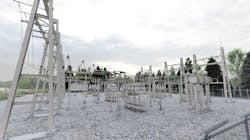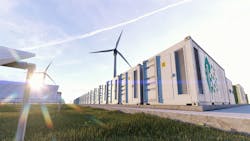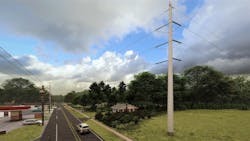Georgia Transmission's Project Visualization
Electrical infrastructure coexists with cities and communities around the globe. Whether it is with residents, business owners or landowners, transmission and distribution lines often pose concerns to various groups based on their location and anticipated perception. At Georgia Transmission Corp., these are just a few of the many stakeholders who have a voice when it comes to building new lines or upgrading existing infrastructure. For this reason, the electric transmission cooperative implemented a proactive approach when it comes to stakeholder engagement.
Project visualizations are the picture that can say a thousand words, conveying multitudes of information to stakeholders in a simple format that is easy to understand. Although Georgia Transmission has practiced this method for several years, it was enhanced in 2019 when the coop engaged TreeLine Utility Solutions Inc. to provide these services. Based out of Manitoba, Canada, the firm specializes in providing 3-D modeling and photo-realistic visualizations in the energy industry.
TreeLine has worked on multiple projects to date with Georgia Transmission, ranging from new construction to conversion and upgrade projects of existing power line infrastructure. Its visualizations are used for these projects in various ways, but all within the realm of stakeholder engagement. For example, visualizations have been used for public open houses, for presentations with regulators such as the U.S. Fish and Wildlife Service, and as communication pieces for landowners when discussing perceived impacts of such projects. Sometimes visualizations have been used when liaising with nonprofit groups and associations.
Roopville-Jonesville Junction
One of the Georgia Transmission projects involving TreeLine visualizations was a 46-kV transmission line being rebuilt to 230-kV specifications. The Roopville project involved upgrading 18.3 miles (30 km) of 46 kV to 230 kV and realignment of 1.1 miles (1.8 km), where new transmission line construction would be taking place. The project designs called for approximately 180 single-pole structures of either spun-concrete or steel, ranging in height from 90 ft to 120 ft (27 m to 37 m) above grade. Additionally, existing rights-of-way (ROW) — both roadside and cross-country — had to be cleared of vegetation, in accordance with safety and reliability standards. A project consisting of such significant upgrades requires communication with stakeholders to minimize any potential concerns.
Of particular focus was the new 1.1 miles of line to be constructed in Bowdon, Georgia, U.S. This small city is in West Georgia, approximately 64 miles (103 km) west of Atlanta. The new alignment for this line was planned through a historical district of Bowdon, and the historical society association was concerned the line would have a negative impact on the area. Therefore, TreeLine was engaged to produce photo-realistic visualizations for a section of line in this area of high concern.
Renderings were produced, showing the proposed infrastructure to scale, and Georgia Transmission presented them to the state historic preservation office during an engagement meeting for the project. The renderings also were shared with tribes with possible ancestral interest and other consulting parties, including local government and historical associations.
“Treeline Utility Solutions used their combined expertise in the electric utility industry and visualization techniques to enable us to provide photo-realistic images suitable for regulators, landowners and other stakeholders,” said Christy Johnson, senior environmental and regulatory coordinator at Georgia Transmission.
The Roopville project is just one of many examples where Georgia Transmission has been successful at dealing with stakeholders on a project by means of illustrating what the project will look like once complete. Since transmission line construction can be complex, a multitude of information must be exchanged to represent a project visually with both accuracy and quality.
Visualization Capabilities
TreeLine not only specializes in modeling and rendering energy infrastructure but also in environmental modeling. To best present a future project in a real-life rendering, both the project and the environment in which the project is being placed must be represented accurately. This can be an existing environment, such as Georgia Transmission’s Roopville project, but it also can be an anticipated future environment. For example, when clearing ROW for transmission line construction, there oftentimes is a desire to show the future ROW in 5 years or 10 years from project completion. This is done to highlight the low-growing grasses and shrub species that eventually occupy the ROW, and it is more representative of what the project will look like permanently.
TreeLine has worked with conventional approaches like using high-resolution photos, such as drone imagery, and superimposing their 3-D models of a project onto the photo. Although this method has an appropriate application, it is not practiced often at TreeLine, because the photo cannot be manipulated nor can multiple renderings be produced from it at different angles.
When modeling an c in 3-D and placing the proposed project infrastructure into it, this enables visualizations to be produced from numerous different angles, by manipulating the model. This method involves no further modeling, allows the utility to get the best bang for the buck as more than one angle shot typically is required for a project and keeps the door open for other media formats, such as video, augmented reality (AR) and virtual reality (VR). There are so many visualization benefits when not limited to using just still images.
Project videos — such as flyovers or fly throughs — are desirable for open houses, where the video can be looped to run on a TV screen. They also are often used for media and marketing when showcasing or announcing a proposed future project as well as for complex projects where video presentations are the most effective way to communicate with stakeholders. Then, there is the world of AR/VR.
The Workflow
The goal when working with project visualizations is to communicate the project in the most effective way, while maintaining quality and accuracy. This principle applies to both stakeholder engagement and marketing and media needs. The media format selected is a collaborative decision by TreeLine and its clients, like Georgia Transmission. When talking about the services provided TreeLine provides, Tasha Brooks, an environmental specialist at Georgia Transmission, explains “they are a great tool to have in your toolbox that helps regulators, stakeholders, and the general public to visualize and better understand the project’s footprint.”
TreeLine interacts with its clients in a personalized manner. There are no intermediaries, and clients work directly with the team doing the modeling and rendering work. Furthermore, the company does not provide work that will not bring value. What that means is sometimes certain organizations just do not need visualization services given the nature of their business. The first question one can expect to be asked when engaging TreeLine is this: “What is the purpose of the renderings?” By understanding the end use and audience, TreeLine can deliver an effective product.
One perk about working with the company is once their deliverables have been submitted, there often is some expected back and forth that takes place, such as revisions and other photo editing. This time is non-billable. Unless there is a major scope change, all revision work is included in the estimate.
The Takeaway
On top of all the benefits discussed about using visualization services for stakeholder engagement, not only is it common practice among leaders in the energy industry, such as Georgia Transmission, but it is the right thing to do. Being able to tell the story of a project before it is built, by means of visualization media, is critical to successful consultation with stakeholders.
Brent Bencharski ([email protected]) is president of TreeLine Utility Solutions Inc. and cofounded the company with Vice President Erik Baker. Bencharski has a master’s degree from the University of Winnipeg and has worked in the Canadian utility industry for over 12 years, specializing in utility vegetation management as well as stakeholder and community relations.
Christopher Smith serves as the manager of environmental services at Georgia Transmission Corp. He has over 20 years of experience focused on routing and siting new transmission facilities. The electric transmission cooperative owns more than 3500 miles of lines and more than 760 substations. Together, with its member electric membership corporations, they deliver electricity to more than 4.4 million Georgians.
About the Author
Brent Bencharski
Brent Bencharski ([email protected]) is president of TreeLine Utility Solutions Inc. and cofounded the company with Vice President Erik Baker. Bencharski has a master’s degree from the University of Winnipeg and has worked in the Canadian utility industry for over 12 years, specializing in utility vegetation management as well as stakeholder and community relations.
Christopher D. Smith
Christopher Smith serves as the manager of environmental services at Georgia Transmission Corp. He has over 20 years of experience focused on routing and siting new transmission facilities. The electric transmission cooperative owns more than 3500 miles of lines and more than 760 substations. Together, with its member electric membership corporations, they deliver electricity to more than 4.4 million Georgians.



